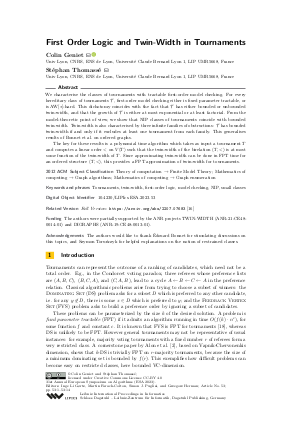@InProceedings{geniet_et_al:LIPIcs.ESA.2023.53,
author = {Geniet, Colin and Thomass\'{e}, St\'{e}phan},
title = {{First Order Logic and Twin-Width in Tournaments}},
booktitle = {31st Annual European Symposium on Algorithms (ESA 2023)},
pages = {53:1--53:14},
series = {Leibniz International Proceedings in Informatics (LIPIcs)},
ISBN = {978-3-95977-295-2},
ISSN = {1868-8969},
year = {2023},
volume = {274},
editor = {G{\o}rtz, Inge Li and Farach-Colton, Martin and Puglisi, Simon J. and Herman, Grzegorz},
publisher = {Schloss Dagstuhl -- Leibniz-Zentrum f{\"u}r Informatik},
address = {Dagstuhl, Germany},
URL = {https://drops.dagstuhl.de/entities/document/10.4230/LIPIcs.ESA.2023.53},
URN = {urn:nbn:de:0030-drops-187061},
doi = {10.4230/LIPIcs.ESA.2023.53},
annote = {Keywords: Tournaments, twin-width, first-order logic, model checking, NIP, small classes}
}

 Creative Commons Attribution 4.0 International license
Creative Commons Attribution 4.0 International license


